
Europe and Mediterranean: Kirkland Signature Spain Intensive Voyage
Azamara Cruises
Home to the great cathedral and The Alcazar, Seville is credited with inventing tapas, and the passionate nature of Sevillanos is evident in their devotion to food as well as bullfighting, flamenco and fiesta. Málaga is the lively capital of the Costa del Sol, which is famed for its beaches and mild climate, and the birthplace of Picasso, as well as the gateway to Andalusia, with its Moorish architectural heritage.

Exclusive Costco member rates
US $ 250 Shipboard credit (per stateroom)
AzAmazing Evenings® event (on most voyages of seven nights or longer)
Select standard spirits, international beers and wines
Bottled water, soft drinks, specialty coffees and teas
Self-service laundry
Shuttle service to and from port communities where available
Concierge services for personal guidance and reservations
Gratuities
Executive Member Benefit
Executive Members receive an annual 2% Reward, up to $1,250, on qualified Costco Travel purchases
Digital Costco Shop Card
Member Exclusive: Digital Costco Shop Card with every Azamara Cruises sailing†
Sailing Itinerary

Note: Cruise itineraries are subject to change. Please verify ports and times directly with the cruise line.
Overview
Visit a bottle of wine. It’s no secret. That’s what Bordeaux is known for and how you’ll likely spend your time in the world’s largest, premium wine district – savoring the wine and the sights. Bordeaux has long been synonymous with fine wines. Situated in the southwest of France in a graceful crescent along a bend in the Garonne River, you’ll find the region that delivers the full-bodied beverages known the world over. Connected to the Bay of Biscay and the Atlantic Ocean by the Gironde River (so wide it appears to be an inlet), the inland port of Bordeaux has been an important trading center since before the Roman era. (The city was founded in the 3rd century BC by a Celtic tribe.) Bordeaux became incredibly prosperous during the 18th century when the city was France’s most important port and a hub for trade to and from the New World. Though its shipping industry has since declined, Bordeaux continues to be a regional transportation center, and its good fortune continues today with wine exports totaling the equivalent of nearly $10 billion US dollars each year. It was the Romans – not the French – who planted the first grape vines along the Garonne River in the 1st century BC. Wine became the lifeblood of the region early on, and in many ways still is. Peak wine production in the 13th century produced export numbers that were not exceeded until the 1950s! The Bordeaux region is one of the largest purveyors of wine in the world, producing over half a billion bottles a year – more than 50% of France’s output. Area vineyards stretch to cover over 520 square miles producing wine that’s shipped to over 160 countries worldwide. No doubt, you’ve sampled more than a few of those bottles. Most of us have. But there is more to Bordeaux than wine. Most business and commercial areas are centered in the relatively small 18th-century downtown area. The buildings that line the quays present stunning examples of the architecture of the Siecle des Lumieres, the Century of Enlightenment. The Place de la Bourse typifies this elegant style, with its slate roof, lower-level arcades, and carved faces adorning the keystones of the arches. You can also visit the nearby Palais Gallien, a ruined Roman amphitheater; the Grand Theatre, the inspiration for the famed Paris Opera House; and the Musee des Beaux-Arts, which features an impressive collection of French paintings. But art and architecture are not the only things the French do well. Gourmet dining is a specialty here, so be sure to indulge in a grand dinner with fine regional wine. Gourmet shopping, of course, goes hand in hand with dining so take a stroll down the Rue Sainte Catherine, Porte Dijeaux, and the Course de Il’intendance, where you’ll find fresh foie gras, truffles, fine cheeses, and a broad selection of wines to enjoy right here or take home for later.
Overview
Visit a bottle of wine. It’s no secret. That’s what Bordeaux is known for and how you’ll likely spend your time in the world’s largest, premium wine district – savoring the wine and the sights. Bordeaux has long been synonymous with fine wines. Situated in the southwest of France in a graceful crescent along a bend in the Garonne River, you’ll find the region that delivers the full-bodied beverages known the world over. Connected to the Bay of Biscay and the Atlantic Ocean by the Gironde River (so wide it appears to be an inlet), the inland port of Bordeaux has been an important trading center since before the Roman era. (The city was founded in the 3rd century BC by a Celtic tribe.) Bordeaux became incredibly prosperous during the 18th century when the city was France’s most important port and a hub for trade to and from the New World. Though its shipping industry has since declined, Bordeaux continues to be a regional transportation center, and its good fortune continues today with wine exports totaling the equivalent of nearly $10 billion US dollars each year. It was the Romans – not the French – who planted the first grape vines along the Garonne River in the 1st century BC. Wine became the lifeblood of the region early on, and in many ways still is. Peak wine production in the 13th century produced export numbers that were not exceeded until the 1950s! The Bordeaux region is one of the largest purveyors of wine in the world, producing over half a billion bottles a year – more than 50% of France’s output. Area vineyards stretch to cover over 520 square miles producing wine that’s shipped to over 160 countries worldwide. No doubt, you’ve sampled more than a few of those bottles. Most of us have. But there is more to Bordeaux than wine. Most business and commercial areas are centered in the relatively small 18th-century downtown area. The buildings that line the quays present stunning examples of the architecture of the Siecle des Lumieres, the Century of Enlightenment. The Place de la Bourse typifies this elegant style, with its slate roof, lower-level arcades, and carved faces adorning the keystones of the arches. You can also visit the nearby Palais Gallien, a ruined Roman amphitheater; the Grand Theatre, the inspiration for the famed Paris Opera House; and the Musee des Beaux-Arts, which features an impressive collection of French paintings. But art and architecture are not the only things the French do well. Gourmet dining is a specialty here, so be sure to indulge in a grand dinner with fine regional wine. Gourmet shopping, of course, goes hand in hand with dining so take a stroll down the Rue Sainte Catherine, Porte Dijeaux, and the Course de Il’intendance, where you’ll find fresh foie gras, truffles, fine cheeses, and a broad selection of wines to enjoy right here or take home for later.
Overview
Bilbao is, a city and seaport in northern Spain, on the Nervión River, near the Bay of Biscay, the capital of Vizcaya Province, in the Basque Country autonomous region. Bilbao consists of an old section, on the right bank of the Nervión, and a modern section, dating from the late 19th century, on the left bank. Several bridges connect the old and new sections. Several railroads and highways and an international airport serve Bilbao. A subway system opened in 1995. One of the major industrial centers of Spain, the city is within a large iron-ore mining region. The chief industries are shipbuilding and the manufacture of cement, chemicals, foodstuffs, iron and steel, machinery, paper, and textiles. Bilbao is an important seaport, and iron ore, cereal grains, and wine are major exports. The chief imports are coal and timber. The Semana Grande is a major bullfighting event held in Bilbao each August. The city has several churches, among them the Gothic Church of Santiago, which dates from the 14th century. It also has several museums, including a collection of archaeological finds relating to the history of the Basques. In October 1997 the Guggenheim Museum Bilbao, with its collection of modern art, opened on Bilbao's waterfront. Among the city's educational institutions is the University of Deusto, a Jesuit university founded in 1886. The author and philosopher Miguel de Unamuno y Jugo was born in Bilbao.
Overview
Ferrol is an important naval station, with one of the largest natural harbors in Spain. The entrance to the harbor is a narrow, fortified strait, through which only one ship at a time can pass. The city is the site of a naval wireless telegraphic station and a large naval arsenal, with a basin containing two dry docks, foundries, and workshops. Nearby is the La Graña submarine base. The industries in the city center around the construction and repair of the ships and docks. Originally a fishing village, El Ferrol was selected (1726) by Charles IV, king of Spain, as a suitable site for a naval station, and a few years later the shipbuilding yards were constructed. El Ferrol is the birthplace of the Spanish dictator Francisco Franco (who was called El Caudillo). It was captured by Franco's army in 1936, soon after the outbreak of the Spanish Civil War.
Overview
Lisbon is Portugal’s hilly, coastal capital city. From the imposing São Jorge Castle, the view encompasses the old city’s pastel-colored buildings, Tagus Estuary, and Ponte 25 de Abril suspension bridge. Nearby, the National Azulejo Museum displays 5 centuries of decorative ceramic tiles. Just outside Lisbon is a string of Atlantic beaches, from Cascais to Estoril.
Overview
According to legend, Sevilla was founded by Hercules, and its origins are linked with the Tartessian civilization. It was called Hispalis under the Romans and Isbiliyabyh by the Moors. Its high point in its history was following the discovery of America. Sevilla lies on the banks of the Guadalquivir and is one of the largest historical centers in Europe, it has the minaret of La Giralda, the cathedral (one of the largest in Christendom), and the Alcazar Palace. Part of its treasures include Casa de Pilatos, the Town Hall, Archive of the Indies (where the historical records of the American continent are kept), the Fine Arts Museum (the second picture gallery in Spain), plus convents, parish churches, and palaces. It has hosted two international exhibitions (1929 and 1992) and is the administrative capital of Andalucía. The quarter of Triana on the other side of the river, La Macarena, Santa Cruz, and San Bartolome, the street of Las Sierpes, plus La Maestranza bullring, Maria Luisa Par,k and the riverside walks are all representative images of Sevilla. For all its important monuments and fascinating history, Seville is universally famous for being a joyous town. While the Sevillians are known for their wit and sparkle, the city itself is striking for its vitality. It is the largest town in Southern Spain, the city of Carmen, Don Juan, and Figaro. In Seville, you will want to visit the old city, with the Cathedral and the GiraldaTowerr at its heart. (You can climb the steps inside the tower for a magnificent view of the City) Very close by are the royal Mudejar palace known as the Alcazar with marvelous gardens and the Santa Cruz quarter, with cramped streets, flowered balconies, richly decorated facades, hidden patios... Other sights not to be missed are, In the old city, the Casa de Pilatos, a large sixteenth-century mansion where Mudejar, Gothic and Renaissance styles blend harmoniously amidst exuberant patios and gardens and, crossing the Triana bridge over the large Guadalquívir river, the lively popular quarter of Triana with charming narrow streets around the church of Santa Ana and traditional ceramic factories.
Overview
According to legend, Sevilla was founded by Hercules, and its origins are linked with the Tartessian civilization. It was called Hispalis under the Romans and Isbiliyabyh by the Moors. Its high point in its history was following the discovery of America. Sevilla lies on the banks of the Guadalquivir and is one of the largest historical centers in Europe, it has the minaret of La Giralda, the cathedral (one of the largest in Christendom), and the Alcazar Palace. Part of its treasures include Casa de Pilatos, the Town Hall, Archive of the Indies (where the historical records of the American continent are kept), the Fine Arts Museum (the second picture gallery in Spain), plus convents, parish churches, and palaces. It has hosted two international exhibitions (1929 and 1992) and is the administrative capital of Andalucía. The quarter of Triana on the other side of the river, La Macarena, Santa Cruz, and San Bartolome, the street of Las Sierpes, plus La Maestranza bullring, Maria Luisa Par,k and the riverside walks are all representative images of Sevilla. For all its important monuments and fascinating history, Seville is universally famous for being a joyous town. While the Sevillians are known for their wit and sparkle, the city itself is striking for its vitality. It is the largest town in Southern Spain, the city of Carmen, Don Juan, and Figaro. In Seville, you will want to visit the old city, with the Cathedral and the GiraldaTowerr at its heart. (You can climb the steps inside the tower for a magnificent view of the City) Very close by are the royal Mudejar palace known as the Alcazar with marvelous gardens and the Santa Cruz quarter, with cramped streets, flowered balconies, richly decorated facades, hidden patios... Other sights not to be missed are, In the old city, the Casa de Pilatos, a large sixteenth-century mansion where Mudejar, Gothic and Renaissance styles blend harmoniously amidst exuberant patios and gardens and, crossing the Triana bridge over the large Guadalquívir river, the lively popular quarter of Triana with charming narrow streets around the church of Santa Ana and traditional ceramic factories.
Overview
According to legend, Sevilla was founded by Hercules, and its origins are linked with the Tartessian civilization. It was called Hispalis under the Romans and Isbiliyabyh by the Moors. Its high point in its history was following the discovery of America. Sevilla lies on the banks of the Guadalquivir and is one of the largest historical centers in Europe, it has the minaret of La Giralda, the cathedral (one of the largest in Christendom), and the Alcazar Palace. Part of its treasures include Casa de Pilatos, the Town Hall, Archive of the Indies (where the historical records of the American continent are kept), the Fine Arts Museum (the second picture gallery in Spain), plus convents, parish churches, and palaces. It has hosted two international exhibitions (1929 and 1992) and is the administrative capital of Andalucía. The quarter of Triana on the other side of the river, La Macarena, Santa Cruz, and San Bartolome, the street of Las Sierpes, plus La Maestranza bullring, Maria Luisa Par,k and the riverside walks are all representative images of Sevilla. For all its important monuments and fascinating history, Seville is universally famous for being a joyous town. While the Sevillians are known for their wit and sparkle, the city itself is striking for its vitality. It is the largest town in Southern Spain, the city of Carmen, Don Juan, and Figaro. In Seville, you will want to visit the old city, with the Cathedral and the GiraldaTowerr at its heart. (You can climb the steps inside the tower for a magnificent view of the City) Very close by are the royal Mudejar palace known as the Alcazar with marvelous gardens and the Santa Cruz quarter, with cramped streets, flowered balconies, richly decorated facades, hidden patios... Other sights not to be missed are, In the old city, the Casa de Pilatos, a large sixteenth-century mansion where Mudejar, Gothic and Renaissance styles blend harmoniously amidst exuberant patios and gardens and, crossing the Triana bridge over the large Guadalquívir river, the lively popular quarter of Triana with charming narrow streets around the church of Santa Ana and traditional ceramic factories.
Overview
Gibraltar is a British Overseas Territory and headland, on Spain's south coast. It’s dominated by the Rock of Gibraltar, a 426m-high limestone ridge. First settled by the Moors in the Middle Ages and later ruled by Spain, the outpost was ceded to the British in 1713. Layers of fortifications include the remains of a 14th-century Moorish Castle and the 18th-century Great Siege Tunnels, which were expanded in WWII.
Overview
Málaga is a port city on southern Spain’s Costa del Sol, known for its high-rise hotels and resorts jutting up from yellow-sand beaches. Looming over that modern skyline are the city’s 2 massive hilltop citadels, the Alcazaba and ruined Gibralfaro, remnants of Moorish rule. The city's soaring Renaissance cathedral is nicknamed La Manquita ("one-armed lady") because one of its towers was curiously left unbuilt.
Overview
The capital of the region with a population of 168,000, Cartegena was founded, as its name suggests, by the Carthaginians in 227 BC and it became Hannibal’s capital city on the Iberian Peninsula. Today it is a modern, industrial city although relics of the past are still highly visible. The narrow streets of the old town were built around the ruined 13th-century cathedral. There are several sites of historical interest including the remains of the Roman road, an old Roman theatre and the Literna (an ancient lighthouse of Moorish origins). Cartagena’s ancient seaport and naval dockyard is where the first submarine was built in 1900 and where submarines are still built today. The port consists of a deep bay with a natural harbour, hence the town’s historical importance. Cartagena has a large shopping centre, plenty of supermarkets and other amenities you would expect to find in a large town including a hospital, schools and sports facilities. The town is the major service centre for the Costa Calida urbanizations that continue to develop around it.Cartegena is 30 minutes drive from Murcia via the N301San Javier airport is 15km from Cartagena.The excellent golf courses at La Manga, which has 3 18-hole courses of international standard, are 20km away.
Overview
Valencia is a vibrant, cosmopolitan city on the Mediterranean coast. Once the capital of its kingdom, it is now a regional capital and Spain’s third-largest city. Surrounded by orange orchards and sandy beaches, the city enjoys year-round sunshine and has become a popular conference center. The city was founded by the Romans, taken by the Visigoths, and prospered under the Moors. Each civilization has left its mark and the historic center includes a 13th-century cathedral (La Seo) with paintings by Goya, and a splendid Gothic 15th-century silk exchange (La Lonja). However, the city is looking to the future and is now home to one of Europe’s most exciting urban development projects. Some $200m has been invested in building an immense and futuristic Arts and Science Centre ( Ciutat de les Arts I les Ciencies ) near the port area. Valencia’s mild climate is another reason to come for a stay. Its warm atmosphere is always inviting and hospitable. Ready to be enjoyed. Valencia means commerce and culture, cinema, theatre, museums, music, and business. It is acentere for industrial design and avant-garde movements. During your stay in Valencia, you will also be able to enjoy the peace of several exceptional natural sites. Between the sea and the rice paddies, closed in by two river mouths, the Albufera Natural Park is a paradise for migratory birds and a recreation area for the city. Along the coast next to the Albufera are broad sandy beaches. There are pleasant recreation areas where people come to enjoy the sun and the sea. No visit to Valencia would be complete without a taste of its ample Mediterranean cuisine based on a fertile ‘Huerta’ or market garden, and fresh fish and shellfish. The queen of local products is rice, served in an infinity of manners as the internationally acclaimed Valencian paella.
Overview
Barcelona is a charming, cosmopolitan port on the shores of the Mediterranean Sea. This prosperous and bilingual (Spanish and Catalan) metropolis measures up to a city such as Madrid: its museums, theaters, art galleries, and nightlife area are of an impressively high standard. Besides that, this art and design center has a lot of interesting sights to offer to its visitors. The best place to watch people go by, stroll, or simply relax, is 'Las Ramblas', a pedestrian street with dozens of outdoor cafes. Here, you’ll find flower stands, book kiosks, and small market stalls where they sell birds and small animals. You’ll also find an endlessly fascinating flowing receptacle of pageant jugglers, singers, dancers, puppeteers, sidewalk artists, living statues, and assorted oddballs on parade. Nearby is 'Place Real', with plenty of bars and restaurants, and 'Palau Guell', built by the Catalan architectural genius Antoni Gaudi in his undulating art-nouveau style. After having seen these sights, stroll the narrow winding streets of the 'Barri Gotic', the medieval Gothic quarter full of interesting tapas bars, and cafes. Check out Picasso’s old hangout, 'Els Quatre Gats', which has been renovated without losing its bohemian charm. Or head for the old Barceloneta section on the waterfront. This working-class area, which was always slightly rundown and scruffy-looking, is now packed with paella restaurants. The new beach area, which runs from Barceloneta to the Olympic Village, is much cleaner than the old beach area. Although some people believe that it has been cleaned up considerably, it might be a wise idea to stay out of the water. Fortunately, the beach itself is already a feast for the eyes (and ears), with its huge and roaring waves.
Onboard the Azamara Journey
Azamara Journey
Year Built: 2000
Year Refurbished: 2016
Double Occupancy Capacity: 690
Azamara Journey® features more balconies than many cruise ships and butler service in each suite. Like it's sister ship, Quest, it's a mid-sized beauty with a deck plan well-suited to the needs of modern voyagers.
Activities & Services (included in cruise)

Pool - Outdoor
- Card Room
- Casino
- Theater/Show Lounge
- Fitness Center
- Sauna/Steam Room
- Pool - Outdoor
- Whirlpool/Jacuzzi
- Bars/Lounges
- Business Center
- Concierge Desk
- Duty-Free Shops/Boutiques
- Elevators
- Safe Deposit Boxes
Activities & Services (available for an extra fee)

Full-Service Spa
- Beauty Salon
- Fitness Classes
- Full-Service Spa
- Internet Center
- Dry Cleaning/ Laundry Service
- Infirmary/Medical Center
- Self-Service Laundromat

Discoveries
Main Dining
Discoveries Restaurant (open seating): Discover the world through dishes and flavors from the places you visit. Whether it’s a Destination Immersion dinner buffet or the Destination Immersion cuisine on the dinner menu, give your dining a little local flavor and enjoy on shore tastes onboard! You will also enjoy a wide variety of nightly selections such as filet mignon with black truffle sauce. With its elegant yet lively dining and renewed décor, it’s easy to see why this restaurant is the culinary heart of the ship. Reservations are not accepted. Choose being seated at a table for two or as part of a larger group of fellow guests.

Prime C
Specialty Dining
Aqualina: At Aqualina, you’ll find some of Italy’s most celebrated dishes as well as contemporary inventive cuisine. Start with lobster ravioli, followed by arugula and radicchio with prosciutto chips, and a Venetian seafood platter. You won’t be able to say no to these famous desserts: marsala custard, lemon soufflé, or tiramisu. The chefs love to be inspired, so after an on shore visit to a local market, you can also expect a delectable dish so local, you’ll feel like you’re not onboard anymore.
Prime C: At Prime C, you’re in for more than an array of delectable dining such as steaks cooked to perfection, crab cakes with remoulade, lobster bisque, lamb, game hens and seafood. Last but certainly not least, try the mini cinnamon-sugar donuts with dipping sauces for dessert. Expect a marvelous evening in a warm wood-paneled ambiance with stunning views and lush décor. If the chef has made a visit to a local market while in port, you’ll also have an authentic local dish to look forward to.
Specialty Dining: Guests staying in a suite are welcome to dine any night of the voyage in Aqualina or Prime C at no charge. Guests who have booked a Club Veranda, Club Oceanview, or Club Interior stateroom are subject to a USD 30 per-person cover charge in Aqualina or Prime C.

Windows Café
Casual Dining
Mosaic Café and Mosaic @Night: Comfortable and stylish, Mosaic is the place where you'll find your favorite coffee drinks, just the way you like (for an additional fee). Slip into a comfortable seat and sip for a while. The perfect place to start (or end) your day, no matter where you are in the world. This just might become your favorite area on the ship.
The Patio and Swirl & Top: Casual "pool grill" by day, then fine tablecloths and flickering candles will set the mood for a sit-down al fresco dining experience by night. Taste your way around the world with exclusive personalized dishes using local flavors of the places visited on the Destination Immersion® cuisine dinner menu served by professional wait staff. And for a little touch of whimsy, a self-serve frozen yogurt station—Swirl & Top. With a variety of flavors and your choice of toppings, it's the perfect way to cool off during the day or end your evening meal.
Windows Café: The best way to see where you are in the world is not by looking at your itinerary, but by checking out the menu at Windows Café! The daily themed dinner often takes its inspiration from the region you are visiting. There’s even a live station made from local ingredients purchased in port: Greek salad made with local feta (Greece), pasta prepared with local mushrooms (Italy), fresh Mussels served with garlic bread (Netherlands). Take in the fresh breeze at an outdoor table and relax in the easy and casual atmosphere of the newly renovated Windows Café. Enjoy an intimate breakfast, lunch, or dinner for two or a lively meal for six with flexible seating options. And speaking of choices, selections change daily. Choose from fresh sushi, stir-fry and pasta, salads, smoked lox and other cold fish, a carving station and of course, desserts.
Room Service: Room service is available 24-hours a day. Order from the full breakfast menu between 6:30 AM and 10:00 AM, and have it delivered at your appointed time. Lunch and dinner room service features a menu of hearty soups, fresh salads, gourmet sandwiches, pizzas and desserts.
Disclaimer regarding ship dining
Alluring inside staterooms feature modern amenities, furnishings and European linens.
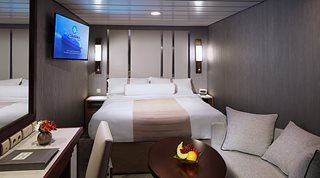
Category: 12
Explore the world in comfort and luxury in this stylish, elegant stateroom featuring all the amenities of a boutique hotel at sea. Relax with plush cotton robes and slippers, 24-hour room service, and more.
Suite Features- Two lower beds convertible to one Queen size bed
- 40" flat-screen television
- Refrigerator with mini-bar
- Thermostat-controlled air conditioner
- Direct-dial telephone with voicemail
- Writing desk
- In-room safe
- Hand-held hairdryer
- USB ports under bedside reading lamps
- Stateroom: 158 sq. ft. (14.7 sq. m.)
- Luxurious cotton bed linens with duvet
- Terry bathrobes and slippers
- 24-hour room service
- Fresh-cut flowers
- Tote bag
- Use of umbrella
- Shoe shine service
- Turndown treats
- Daily news bulletin

Category: 11
Explore the world in comfort and luxury in this stylish, elegant stateroom featuring all the amenities of a boutique hotel at sea. Relax with plush cotton robes and slippers, 24-hour room service, and more.
Suite Features- Two lower beds convertible to one Queen size bed
- 40" flat-screen television
- Refrigerator with mini-bar
- Thermostat-controlled air conditioner
- Direct-dial telephone with voicemail
- Writing desk
- In-room safe
- Hand-held hairdryer
- USB ports under bedside reading lamps
- Stateroom: 158 sq. ft. (14.7 sq. m.)
- Luxurious cotton bed linens with duvet
- Terry bathrobes and slippers
- 24-hour room service
- Fresh-cut flowers
- Tote bag
- Use of umbrella
- Shoe shine service
- Turndown treats
- Daily news bulletin

Category: 10
Explore the world in comfort and luxury in this stylish, elegant stateroom featuring all the amenities of a boutique hotel at sea. Relax with plush cotton robes and slippers, 24-hour room service, and more.
Suite Features- Two lower beds convertible to one Queen size bed
- 40" flat-screen television
- Refrigerator with mini-bar
- Thermostat-controlled air conditioner
- Direct-dial telephone with voicemail
- Writing desk
- In-room safe
- Hand-held hairdryer
- USB ports under bedside reading lamps
- Stateroom: 158 sq. ft. (14.7 sq. m.)
- Luxurious cotton bed linens with duvet
- Terry bathrobes and slippers
- 24-hour room service
- Fresh-cut flowers
- Tote bag
- Use of umbrella
- Shoe shine service
- Turndown treats
- Daily news bulletin

Category: 09
Explore the world in comfort and luxury in this stylish, elegant stateroom featuring all the amenities of a boutique hotel at sea. Relax with plush cotton robes and slippers, 24-hour room service, and more.
Suite Features- Two lower beds convertible to one Queen size bed
- 40" flat-screen television
- Refrigerator with mini-bar
- Thermostat-controlled air conditioner
- Direct-dial telephone with voicemail
- Writing desk
- In-room safe
- Hand-held hairdryer
- USB ports under bedside reading lamps
- Stateroom: 158 sq. ft. (14.7 sq. m.)
- Luxurious cotton bed linens with duvet
- Terry bathrobes and slippers
- 24-hour room service
- Fresh-cut flowers
- Tote bag
- Use of umbrella
- Shoe shine service
- Turndown treats
- Daily news bulletin

Category: Z
This category can be booked for a special rate, guaranteed to you. Please note that the category is not associated at the time of booking with a specific stateroom, deck, bedding configuration or other particular settings. The assignment of an actual cabin will be performed during your check-in. The cabin can be anywhere on the ship.
Attractive staterooms feature an ocean view or an obstructed view, with either a picture window or a porthole, plus standard features and amenities.
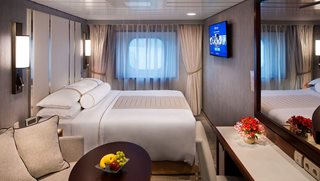
Category: 08
Revel in the polished style and stellar service of your own private retreat, boasting a modern and contemporary décor. Enjoy picturesque ocean views outside your window, and all the finer touches included in every stateroom.
Suite Features- Two lower beds convertible to one Queen size bed
- Some staterooms feature sofa bed
- 40" flat-screen TV
- Refrigerator with mini-bar
- Thermostat-controlled air conditioner
- Direct-dial telephone with voicemail
- Writing desk
- In-room safe
- Hand-held hairdryer
- USB ports under bedside reading lamps
- 143 sq. ft. (13.3 sq m)
- Luxurious cotton bed linens with duvet
- Terry bathrobes and slippers
- 24-hour room service
- Fresh-cut flowers
- Tote bag
- Use of umbrella
- Shoe shine service
- Turndown treats

Category: 06
Revel in the polished style and stellar service of your own private retreat, boasting a modern and contemporary décor. Enjoy picturesque ocean views outside your window, and all the finer touches included in every stateroom.
Suite Features- Two lower beds convertible to one Queen size bed
- Some staterooms feature sofa bed
- 40" flat-screen TV
- Refrigerator with mini-bar
- Thermostat-controlled air conditioner
- Direct-dial telephone with voicemail
- Writing desk
- In-room safe
- Hand-held hairdryer
- USB ports under bedside reading lamps
- 143 sq. ft. (13.3 sq m)
- Luxurious cotton bed linens with duvet
- Terry bathrobes and slippers
- 24-hour room service
- Fresh-cut flowers
- Tote bag
- Use of umbrella
- Shoe shine service
- Turndown treats

Category: 05
Revel in the polished style and stellar service of your own private retreat, boasting a modern and contemporary décor. Enjoy picturesque ocean views outside your window, and all the finer touches included in every stateroom.
Suite Features- Two lower beds convertible to one Queen size bed
- Some staterooms feature sofa bed
- 40" flat-screen TV
- Refrigerator with mini-bar
- Thermostat-controlled air conditioner
- Direct-dial telephone with voicemail
- Writing desk
- In-room safe
- Hand-held hairdryer
- USB ports under bedside reading lamps
- 143 sq. ft. (13.3 sq m)
- Luxurious cotton bed linens with duvet
- Terry bathrobes and slippers
- 24-hour room service
- Fresh-cut flowers
- Tote bag
- Use of umbrella
- Shoe shine service
- Turndown treats

Category: 04
Revel in the polished style and stellar service of your own private retreat, boasting a modern and contemporary décor. Enjoy picturesque ocean views outside your window, and all the finer touches included in every stateroom.
Suite Features- Two lower beds convertible to one Queen size bed
- Some staterooms feature sofa bed
- 40" flat-screen TV
- Refrigerator with mini-bar
- Thermostat-controlled air conditioner
- Direct-dial telephone with voicemail
- Writing desk
- In-room safe
- Hand-held hairdryer
- USB ports under bedside reading lamps
- 143 sq. ft. (13.3 sq m)
- Luxurious cotton bed linens with duvet
- Terry bathrobes and slippers
- 24-hour room service
- Fresh-cut flowers
- Tote bag
- Use of umbrella
- Shoe shine service
- Turndown treats

Category: Y
This category can be booked for a special rate, guaranteed to you. Please note that the category is not associated at the time of booking with a specific stateroom, deck, bedding configuration or other particular settings. The assignment of an actual cabin will be performed during your check-in. The cabin can be anywhere on the ship.
Elegantly appointed staterooms feature modern amenities and furnishings, a veranda, a sitting area with sofa bed and floor-to-ceiling sliding glass doors.
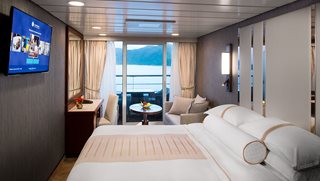
Category: V1
Refreshing sea breezes and stunning destination views come standard in our staterooms that offer your own private veranda. Greet the day with room service on your balcony, or toast to another stunning sunset. Polished touches and professional service perfectly compliment the warm, friendly attention you'll receive from the staff and crew.
Suite Features- Veranda
- Two lower beds convertible to one Queen size bed
- Sitting area with 40" flat-screen TV
- Refrigerator with mini-bar
- Thermostat-controlled air conditioner
- Direct-dial telephone with voicemail
- Writing desk
- In-room safe
- Hand-held hairdryer
- USB ports under bedside reading lamps
- Stateroom: 175 sq. ft. (16.3 sq. m.); Veranda: 40 sq. ft. (3.7 sq. m.)
- Luxurious cotton bed linens with duvet
- Terry bathrobes and slippers
- 24-hour room service
- Fresh-cut flowers
- Tote bag
- Use of umbrella
- Shoe shine service
- Turndown treats
- Daily news bulletin

Category: V2
Refreshing sea breezes and stunning destination views come standard in our staterooms that offer your own private veranda. Greet the day with room service on your balcony, or toast to another stunning sunset. Polished touches and professional service perfectly compliment the warm, friendly attention you'll receive from the staff and crew.
Suite Features- Veranda
- Two lower beds convertible to one Queen size bed
- Sitting area with 40" flat-screen TV
- Refrigerator with mini-bar
- Thermostat-controlled air conditioner
- Direct-dial telephone with voicemail
- Writing desk
- In-room safe
- Hand-held hairdryer
- USB ports under bedside reading lamps
- Stateroom: 175 sq. ft. (16.3 sq. m.); Veranda: 40 sq. ft. (3.7 sq. m.)
- Luxurious cotton bed linens with duvet
- Terry bathrobes and slippers
- 24-hour room service
- Fresh-cut flowers
- Tote bag
- Use of umbrella
- Shoe shine service
- Turndown treats
- Daily news bulletin

Category: V3
Refreshing sea breezes and stunning destination views come standard in our staterooms that offer your own private veranda. Greet the day with room service on your balcony, or toast to another stunning sunset. Polished touches and professional service perfectly compliment the warm, friendly attention you'll receive from the staff and crew.
Suite Features- Veranda
- Two lower beds convertible to one Queen size bed
- Sitting area with 40" flat-screen TV
- Refrigerator with mini-bar
- Thermostat-controlled air conditioner
- Direct-dial telephone with voicemail
- Writing desk
- In-room safe
- Hand-held hairdryer
- USB ports under bedside reading lamps
- Stateroom: 175 sq. ft. (16.3 sq. m.); Veranda: 40 sq. ft. (3.7 sq. m.)
- Luxurious cotton bed linens with duvet
- Terry bathrobes and slippers
- 24-hour room service
- Fresh-cut flowers
- Tote bag
- Use of umbrella
- Shoe shine service
- Turndown treats
- Daily news bulletin

Category: X
This category can be booked for a special rate, guaranteed to you. Please note that the category is not associated at the time of booking with a specific stateroom, deck, bedding configuration or other particular settings. The assignment of an actual cabin will be performed during your check-in. The cabin can be anywhere on the ship.
Suite amenities include butler service, limited internet minutes, specialty dining, free bag of laundry, in-suite tea service, and an additional onboard credit for Top Suites
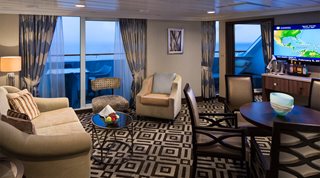
Category: CO
With a large living room and a separate bedroom—plus your own private veranda—your suite offers a restful retreat after your immersive experiences on land. Enjoy elegant, contemporary décor, and rich marble touches. You'll be spoiled by the attention to detail in these beautiful suites, and of course, all the pampering too.
Suite Features- Spacious living room with a separate master bedroom
- Master bedroom with one queen size bed with a 55" flat-screen television
- 55" flat-screen television in living room
- Marble master bathroom with shower. Journey and Quest suites feature a tub.
- Dressing room with vanity and ample closet space
- Floor-to-ceiling sliding glass doors in living room and master bedroom
- Mini-bar
- Thermostat-controlled air conditioner
- Direct-dial telephone with voice mail
- Writing desk
- In-room safe
- Hand-held hair dryer
- Stateroom: 440–501 sq. ft. (40.9-46.5 sq. m.)
- Veranda: 233 sq. ft. (21.7 sq. m.)
- Luxurious cotton bed linens with duvet
- Terry bathrobes and slippers
- 24-hour room service
- Fresh-cut flowers
- Tote bag
- Use of umbrella
- Shoe shine service
- Turndown treats
- Daily news bulletin
- Complimentary Internet (240 minutes or 100% off the unlimited internet package)
- One free bag of laundry service per suite, each seven days
- Complimentary specialty dining
- Complimentary access to the Thalassotherapy pool and spa deck
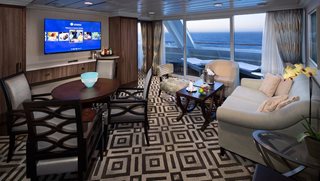
Category: CW
The largest suites have been transformed with contemporary design elements that are both elegant and organic, with design that draws inspiration from nature—a sandy cliff, flowing river beds, exquisite white sand beaches, and rustling grasses. Enjoy a spacious living room, separate bedroom and all the amenities that come with the most luxurious suite on the ship.
Suite Features- Spacious living room with a separate master bedroom
- Master bedroom with one queen size bed and a 40" flat-screen television
- 55" flat-screen television in living room
- Marble master bathroom with shower. Journey and Quest suites feature a tub.
- Dressing room with vanity and ample closet space
- Floor-to-ceiling sliding glass doors in living room and master bedroom
- Mini-bar
- Thermostat-controlled air conditioner
- Direct-dial telephone with voice mail
- Writing desk
- In-room safe
- Hand-held hair dryer
- Stateroom: 560 sq. ft. (52 sq. m.) Veranda: 233 sq. ft. (21.7 sq. m.)
- Luxurious cotton bed linens with duvet
- Terry bathrobes and slippers
- 24-hour room service
- Fresh-cut flowers
- Tote bag
- Use of umbrella
- Shoe shine service
- Turndown treats
- Daily news bulletin
- Complimentary Internet (240 minutes or 100% off the unlimited internet package)
- One free bag of laundry service per suite, each seven days
- Complementary specialty dining
- Complimentary access to the Thalassotherapy pool and spa deck
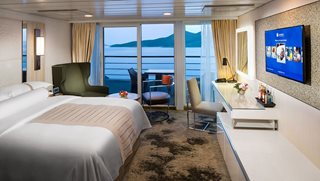
Category: N1
Spacious and comfortable, the Club Continent Suites feature fresh new décor inspired by natural elements. With two beds convertible to a queen, a cozy sitting area, breezy balcony and refreshed bathroom with a bathtub or shower, this is your wonderful, refined home away from home.
Suite Features- Two lower beds convertible to one queen size bed
- Spacious and comfortable sitting area
- 55" flat-screen television in sitting area
- Roomy bathroom with shower. Some also feature a tub.
- Floor-to-ceiling sliding glass doors
- Veranda
- Mini-bar
- Thermostat-controlled air conditioner
- Direct-dial telephone with voice mail
- Writing desk
- In-room safe
- Hand-held hair dryer
- Stateroom: 266 sq. ft. (24.7 sq. m.) Veranda: 60 sq. ft. (5.6 sq. m.)
- Luxurious cotton bed linens with duvet
- Terry bathrobes and slippers
- 24-hour room service
- Fresh-cut flowers
- Tote bag
- Use of umbrella
- Shoe shine service
- Turndown treats
- Daily news bulletin
- Complimentary Internet (240 minutes or 50% off the unlimited internet package)
- One free bag of laundry service per suite, each seven days
- Complimentary specialty dining
- Complimentary access to the Thalassotherapy pool and spa deck

Category: N2
Spacious and comfortable, the Club Continent Suites feature fresh new décor inspired by natural elements. With two beds convertible to a queen, a cozy sitting area, breezy balcony and refreshed bathroom with a bathtub or shower, this is your wonderful, refined home away from home.
Suite Features- Two lower beds convertible to one queen size bed
- Spacious and comfortable sitting area
- 55" flat-screen television in sitting area
- Roomy bathroom with shower. Some also feature a tub.
- Floor-to-ceiling sliding glass doors
- Veranda
- Mini-bar
- Thermostat-controlled air conditioner
- Direct-dial telephone with voice mail
- Writing desk
- In-room safe
- Hand-held hair dryer
- Stateroom: 266 sq. ft. (24.7 sq. m.) Veranda: 60 sq. ft. (5.6 sq. m.)
- Luxurious cotton bed linens with duvet
- Terry bathrobes and slippers
- 24-hour room service
- Fresh-cut flowers
- Tote bag
- Use of umbrella
- Shoe shine service
- Turndown treats
- Daily news bulletin
- Complimentary Internet (240 minutes or 50% off the unlimited internet package)
- One free bag of laundry service per suite, each seven days
- Complimentary specialty dining
- Complimentary access to the Thalassotherapy pool and spa deck
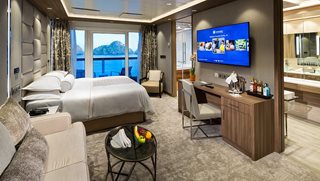
Category: SP
Located next to the tranquil Sanctum Spa, our newest suites are the ultimate in contemporary design, comfort and pampering. With easy access to the Spa, open decks, swimming pool and our great restaurants, the Club Spa Suites surround you with organic, elegant décor, and the finest, most soothing amenities. Suites feature comfortable sitting area, daily delivery of healthy snacks, Frette plush robes and slippers, and in-room spa music. For the ultimate in serene surroundings, the spacious glass-enclosed spa soaking tub and separate rain shower bring the outside in, with views to the endless seas beyond. The perfect place to get away from it all, without being far from anything.
Suite Features- Two lower beds convertible to one queen size bed
- Spacious glass-enclosed bathtub
- Separate rain shower
- Comfortable sitting area
- 55" flat-screen television in sitting area
- Floor-to-ceiling sliding glass doors
- Veranda
- Mini-bar
- Thermostat-controlled air conditioner
- Direct-dial telephone with voice mail
- Writing desk
- In-room safe
- Hand-held hair dryer
- Stateroom: 414 sq. ft. (38.5 sq. m.)
- Veranda: 40 sq. ft. (3.7 sq. m.)
- Priority embarkation and debarkation
- Complimentary Internet (240 minutes or 100% off the unlimited internet package)
- One free bag of laundry service per suite, each seven days
- Complimentary seating in the specialty restaurants dining
- Complimentary in-room spirits
- Complimentary access to the Thalassotherapy pool and spa deck
- Luxurious cotton bed linens with duvet
- Terry bathrobes and slippers
- 24-hour room service
- Fresh-cut flowers
- Tote bag
- Use of umbrella
- Shoe shine service
- Turndown treats
- Daily news bulletin

Category: W
This category can be booked for a special rate, guaranteed to you. Please note that the category is not associated at the time of booking with a specific stateroom, deck, bedding configuration or other particular settings. The assignment of an actual cabin will be performed during your check-in. The cabin can be anywhere on the ship.

| Symbol | Description |
|---|---|
 | Wheelchair-Accessible Stateroom |
 | Convertible Sofa Bed |
 | Connecting Staterooms |
 | Interior Stateroom Door Location |
 | Smoking Area |
 | Suite with tub |
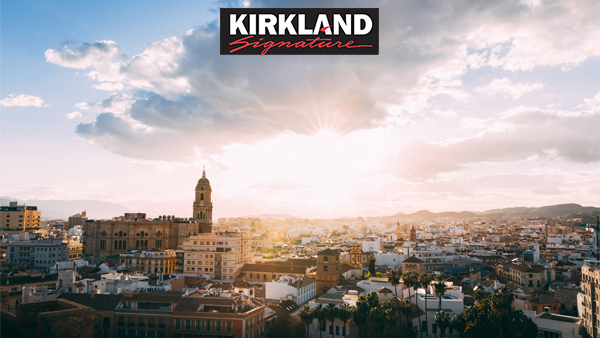
- Ship Name: Azamara Journey
- Year Built: 2000
- Year Refurbished: 2016
- Year Entered Present Fleet: 2007
- Ship Class: Journey
- Maximum Capacity: 690
- Number of Passenger Decks: 8
- Number of Crew: 408
- Officers' Nationality: International
- Ocean-View without Balcony: 73
- Ocean-View with Balcony: 200
- Total Inside Staterooms: 26
- Tonnage (GRT): 30,277
- Capacity Based on Double Occupancy: 690
- Country of Registry: Malta
- Total Staterooms: 345
- Suites with Balcony: 46
- Crew/Hotel Staff Nationality: International
Costco Member Reviews

Available Dates & Prices
Terms & Conditions
*Price shown is per person based on double occupancy, is valid for select stateroom categories only, and does not include the Kirkland Signature Included Extras. The Kirkland Signature rate will be shown in the Rates section on the Stateroom Category page during booking.
♦Included Extras are for first and second passengers only unless noted otherwise, cannot be substituted for other items or services, and have no cash value. Included Extras are not applicable to third and fourth guests, and will expire if not used by 10:00 p.m. on the last evening of the voyage. Cannot be used in the Casino or for future cruise bookings.
†One Digital Costco Shop Card per room/stateroom, per stay. The exact amount of the Digital Costco Shop Card will be calculated during the booking process. The Digital Costco Shop Card promotion is nontransferable and may not be combined with any other promotion. A Digital Costco Shop Card will arrive by email approximately 10 days after the start of your cruise. Click on the Terms & Conditions link below for additional information.
Ship's registry: Malta
Digital Costco Shop Card
This booking includes a Digital Costco Shop Card which will arrive by email one to two weeks after you return from your vacation. The Digital Costco Shop Card is a convenient payment option in our warehouses and on Costco.ca.

















